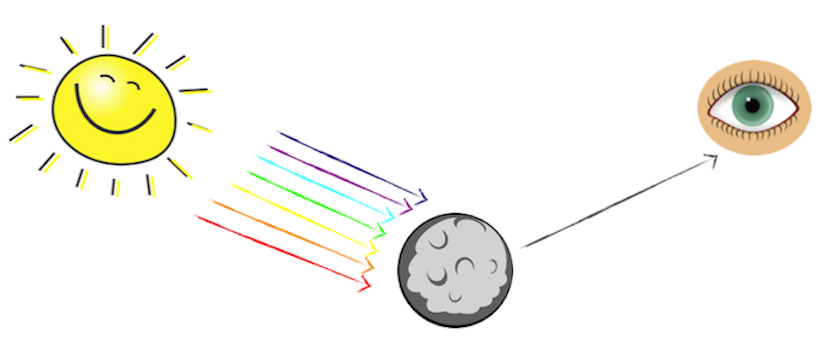What may be seen by the human eye is light or electromagnetic radiation. Electrical radiation can have wavelengths as short as 10-11 meters to as long as hundreds of metres, depending on the type of electromagnetic radiation. Humans can only see wavelengths from 700 nanometers for red light down to 400 nm for violet light within that vast spectrum. Infrared and ultraviolet, on either side of the visual range, are commonly referred to as “light” as well. The current accepted number for the speed of light in a vacuum is 299,792,458 metres per second, or approximately 186,282 miles per second.
Many different ways of describing and utilising the term “light” exist, and no single response is sufficient for all of them. Physical aspects of light interest physicists, while visual beauty fascinates artists. Light is a major means of viewing the world and interacting with others. All life on Earth depends on photosynthesis because the Sun’s rays warm our planet and set in motion global weather patterns. Light’s interactions with matter have had a profound effect on the structure of the cosmos at the largest scale. From the smallest to the largest sizes, light provides an unprecedented view of our cosmos. As a general rule, electromagnetic radiation conveys much of our knowledge about the rest of the universe.
Interpreting radiation from the universe’s early days, measuring its expansion, determining its chemical makeup, astronomers can get a sense of how the universe came to be and how it will evolve in the future. In the same way that the telescope opened up the universe to a wider audience, the microscope opened up the cell to a wider audience. The development of quantum mechanics was greatly influenced by the study of light frequencies emitted and absorbed by atoms. It is still important to study fundamental photochemical reactions using atomic and molecular spectroscopies, which can provide extremely sensitive testing of atomic and molecular models.
The following are a few examples of lighting options:
Natural sources
When it comes to the source of light, we’re all very familiar with the concept. Our universe’s lighting can be found in the natural world. We may use a variety of natural resources to generate light. Things in nature that allow us to live our lives to the fullest because of light include:
The Sun is the major source of light on Earth, and it is also the most critical. The sun is the only natural source capable of generating such a massive amount of energy, a giant ball of fire in which nuclear fusion happens at its core. It is the sun that provides most of the planet’s light and heat energy.
Even if the star’s light reaches Earth in such a small proportion, it is still a light source.
Artificial sources
Using current technology, artificial light is created to mimic the look and feel of natural light (sunlight). A few examples include: light bulbs and tubes. Artificial light was first created in the late nineteenth and early twentieth century. Natural light can be evaluated in two ways: frequency range and lumen strength, both of which are dependent on the intensity of lighting. You’ll be able to see them since they’re everywhere. It is common for people to utilise artificial light in their homes, businesses and public areas. A vast variety of shapes, sizes, colours and brightness levels are available.
Luminescence produced by an incandescent light bulb
An incandescent light source can integrate the sun, light bulbs, and flames. If you heat up an incandescent bulb, you generate electromagnetic radiations, which act as a light source for the entire atom. These materials emit infrared radiation, which has a wavelength of infrared photons, at low temperatures. Heating metal produces photon emissions that are visible to the human eye because the wavelength of their radiation increases in the spectrum when they are emitted. A common incandescent light source is shown here.
Lighting’s Primary Source of Luminescence
Because these lights don’t employ the entire vibration of a material, but merely electrons, they operate at lower temperatures than incandescent bulbs. As a way of dissipation, electrons emit electromagnetic radiations, which are known as luminescence light. An electron’s temperature must be lowered in order to produce a specific colour of light. A few other types of Luminescence lighting include fluorescent and neon lamps, for example. Computer displays and television sets use fluorescent light as a common luminescence light source, which can be further subdivided into electro-luminescence and photo-luminescence. In addition to fireflies, this is the most common luminescence example.
Know how to solve this question:
A) Both A and R are correct and R is the correct explanation of A.
B) Both A and R are correct but R is not the correct explanation of A.
C) A is correct and R is incorrect.
D) Both A and R are incorrect.
Bioluminescence
It is possible for a living entity to produce and emit light, which is known as bioluminescence. A chemiluminescence is a type of this phenomenon. Among marine vertebrates and other invertebrates, as well as some fungi, microbes, and arthropods such as fireflies, bioluminescence is widespread. For example, in some species, such as Vibrio bacteria, the light is created by symbiotic bacteria, such as those from the genus Vibrio.
Light-producing molecules and enzyme are the primary components of bioluminescence, and they’re known as luciferin and luciferase. To distinguish between luciferins and luciferases, the species or group is often used, such as firefly luciferin. The enzyme is responsible for the oxidation of the luciferin in all characterised situations.










